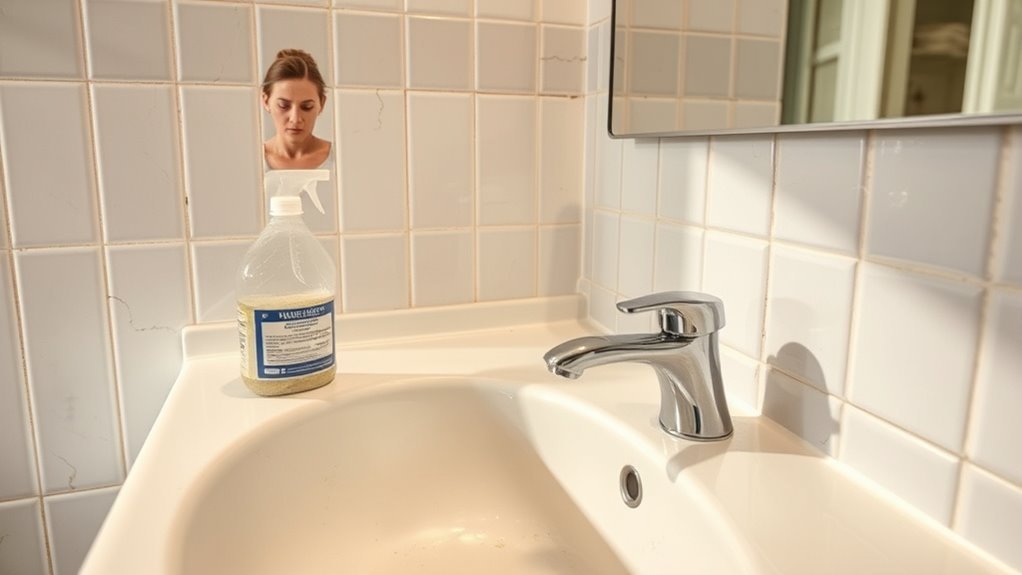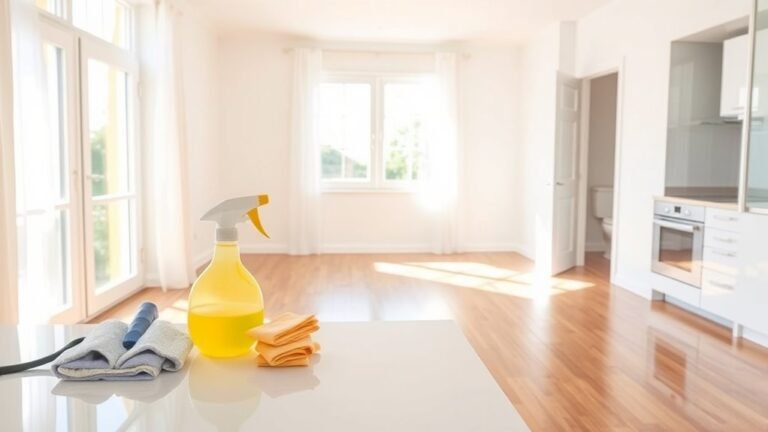Common Mistakes When Cleaning Bathroom
When cleaning your bathroom, avoid harsh chemicals that can damage surfaces and finishes. Don’t neglect fixtures like faucets and showerheads—they need regular care to prevent buildup. Make sure to disinfect hidden germ hotspots such as handles and drains. Avoid scrubbing too hard, which can wear down your surfaces over time. Don’t skip consistent cleaning schedules or reuse the same cloth in multiple areas, and always ventilate to prevent mold growth. Keep these tips in mind, and you’ll uncover more ways to protect your bathroom.
Using Harsh Chemicals That Damage Surfaces

Although harsh chemicals might seem effective, using them can actually damage your bathroom surfaces over time. You want to keep your space fresh without sacrificing the integrity of tiles, countertops, or grout. Instead of reaching for strong chemical cleaners, consider chemical alternatives that are gentler yet still effective. These options respect surface compatibility, ensuring they don’t erode finishes or cause discoloration. By choosing products or homemade solutions designed with your materials in mind, you maintain both cleanliness and the longevity of your bathroom. Embracing safer, surface-friendly options gives you freedom from worrying about unintended damage, letting you enjoy a clean space without compromise. Remember, a mindful approach to cleaning protects your investment and your peace of mind.
Neglecting to Clean Bathroom Fixtures Properly
When you overlook cleaning bathroom fixtures thoroughly, grime and buildup can quickly accumulate, leading to stains and reduced functionality. Different fixture types—like faucets, showerheads, and towel bars—need specific attention and the right cleaning frequency to stay in top shape. Skipping regular care can cause mineral deposits and dull finishes that limit your freedom to enjoy a fresh, inviting bathroom.
| Fixture Type | Recommended Cleaning Frequency |
|---|---|
| Faucet | Weekly |
| Showerhead | Monthly |
| Toilet Handle | Twice weekly |
| Towel Bar | Biweekly |
| Sink Drain | Monthly |
Stick to this schedule, and you’ll avoid grime buildup while keeping your bathroom fixtures working smoothly and looking great.
Overlooking Hidden Germ Hotspots

Even if you keep the obvious areas clean, you might miss spots where germs love to hide. Hidden bacteria often lurk in places like faucet handles, toothbrush holders, and drains—areas you rarely think to disinfect thoroughly. These germ breeding grounds can quickly multiply, undoing your hard work. To truly free your bathroom from harmful bacteria, make a habit of cleaning these overlooked spots regularly. Use disinfectant wipes or sprays designed to reach crevices where germs thrive. Don’t let hidden bacteria sabotage your efforts; targeting these hotspots guarantees a healthier space. By paying attention to these sneaky areas, you not only keep your bathroom fresh but also protect yourself and your loved ones from unnecessary exposure to harmful germs.
Scrubbing Too Aggressively and Causing Wear
You might think scrubbing harder cleans better, but it can actually damage your bathroom surfaces. Using harsh tools or abrasive pads often wears down finishes and causes scratches. It’s important to choose the right cleaning method to protect your fixtures while keeping them spotless.
Damaging Surfaces Unintentionally
One common mistake people make while cleaning their bathroom is scrubbing too aggressively, which can wear down surfaces over time. To protect your bathroom’s finish, you need gentle cleaning techniques that balance effectiveness with surface protection. Instead of scrubbing hard, try using softer materials and letting cleaners work longer. This way, you preserve your freedom to enjoy a clean bathroom without damage.
| Surface Type | Recommended Cleaning Technique |
|---|---|
| Porcelain | Soft sponge, mild detergent |
| Tile grout | Soft brush, gentle cleaner |
| Glass | Microfiber cloth, glass cleaner |
| Stainless steel | Soft cloth, non-abrasive cleaner |
| Natural stone | pH-neutral cleaner, soft cloth |
Treat your bathroom surfaces with care to avoid unintentional damage and maintain their beauty.
Using Harsh Cleaning Tools
Although it might seem like scrubbing harder speeds up cleaning, using harsh tools can actually wear down your bathroom surfaces. When you reach for harsh bristle brushes or abrasive cleaning pads, you risk scratching tiles, dulling fixtures, and eroding grout. These tools aren’t designed for delicate surfaces, and over time, that aggressive scrubbing can cause permanent damage. Instead, choose softer brushes or non-abrasive sponges that clean effectively without compromising your bathroom’s finish. You want to feel free to clean thoroughly without worrying about wear and tear. Remember, a gentle touch paired with the right products often gets the job done better and preserves your bathroom’s look longer. Don’t let harsh tools steal your freedom to maintain a fresh, beautiful space.
Ignoring Regular Cleaning Schedules

A bathroom quickly shows signs of neglect when cleaning is pushed aside. Skipping a regular cleaning schedule lets grime and mold build up, making your space less inviting. To keep your bathroom fresh without feeling chained to chores, focus on these key points:
- Set realistic cleaning frequency based on your usage and lifestyle.
- Use scheduling reminders on your phone or calendar to stay consistent.
- Break tasks into small, manageable chunks so cleaning feels less overwhelming.
Using the Same Cloth for Different Areas
If you use the same cloth for different areas in your bathroom, you risk spreading germs instead of cleaning them up. This careless habit increases cross contamination risks, turning your cleaning efforts into a health hazard. You want your bathroom to feel fresh and safe, not a breeding ground for bacteria. Instead, assign separate cloths for the toilet, sink, and shower. After each use, apply proper cloth sanitization techniques—like washing in hot water or disinfecting with bleach—to keep them germ-free. This simple change gives you the freedom to clean confidently, knowing you’re not transferring grime from one surface to another. Taking these steps guarantees your bathroom stays truly clean and healthy, so you can enjoy your space without worry.
Forgetting to Ventilate During and After Cleaning
You might overlook the importance of ventilating your bathroom while cleaning, but it’s essential for your safety. Without proper airflow, harmful fumes from cleaning products can build up and cause health issues. Always make sure to open a window or turn on the exhaust fan during and after cleaning to keep the air fresh.
Importance of Proper Ventilation
Proper ventilation plays an essential role in bathroom cleaning, yet many forget to open windows or turn on exhaust fans during and after the process. You might think it’s a small step, but the ventilation benefits are huge. Without proper airflow techniques, you limit how fresh and clean your bathroom can truly feel. To make the most of ventilation, try these simple tips:
- Always open windows or doors to encourage natural airflow.
- Use exhaust fans to quickly remove fumes and moisture.
- Keep vents and airways clear for continuous circulation.
Risks of Poor Airflow
Neglecting to ventilate during and after cleaning can lead to several problems that undermine your efforts. Without proper air circulation, cleaning fumes linger, making the bathroom uncomfortable and even unsafe. Poor airflow traps humidity, creating a perfect breeding ground for mold and mildew, which can damage surfaces and harm your health. When you skip ventilating, moisture sticks around longer, reversing the freshness you worked hard to achieve. Controlling humidity is essential—not just for drying surfaces but for keeping your space fresh and inviting. By ensuring good air circulation during and after cleaning, you protect your bathroom from persistent dampness and maintain the freedom to enjoy a clean, healthy space. Don’t let poor airflow undo your hard work; always open windows or run fans to keep your bathroom fresh and dry.
Frequently Asked Questions
Can Natural Cleaning Products Be as Effective as Chemical Cleaners?
You might wonder if natural cleaning products can match the cleaning efficacy of chemical cleaners. The truth is, natural ingredients like vinegar, baking soda, and lemon have impressive power to tackle grime without harsh chemicals. If you value freedom from toxins and want effective results, these natural options can be just as reliable. Plus, they’re safer for you and the environment, letting you clean confidently without compromise.
How Often Should I Replace My Bathroom Cleaning Tools?
You should replace your bathroom cleaning tools based on cleaning frequency and tool maintenance. If you clean weekly, swapping out sponges or brushes every 1-2 months helps keep things fresh and hygienic. For less frequent cleaning, tools might last longer, but don’t ignore wear and tear. Regularly rinsing and drying your tools extends their life, giving you more freedom from constant replacements while keeping your bathroom spotless and safe.
What Are the Best Methods to Prevent Mold Buildup?
To prevent mold buildup, you’ll want to focus on mold resistance techniques like using mold-resistant paint and materials in your bathroom. You should also practice humidity control methods—keep the space well-ventilated by using exhaust fans or opening windows after showers. Running a dehumidifier can help too. These steps give you the freedom to enjoy a fresh, clean bathroom without worrying about mold creeping in.
Is It Necessary to Wear Gloves When Cleaning the Bathroom?
Imagine stepping into a battle where your hands are the frontline soldiers. Wearing gloves offers you essential skin protection, guarding against harsh chemicals and germs lurking in bathroom grime. The glove benefits are clear: they prevent irritation, dryness, and possible infections, letting you clean freely without worry. You don’t have to be confined by sensitive skin—gloves give you the freedom to tackle the mess confidently, keeping your hands safe and healthy.
How Can I Safely Clean Grout Without Damaging It?
When tackling grout cleaning, you’ll want to choose safe products that won’t eat away at your tiles or cause discoloration. Avoid harsh chemicals like bleach; instead, go for pH-neutral cleaners or a mix of baking soda and water. Use a soft brush to gently scrub the grout lines—don’t go heavy-handed, or you risk damage. This way, you keep your grout fresh and intact, giving you the freedom to enjoy a clean bathroom without worry.






